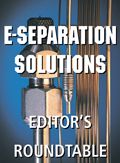Technology Forum: Editor's Roundtable
This month's Technology Forum looks at the topic of publishing and the trends and issues surrounding it. Joining us for this discussion is the LCGC staff of David Walsh, Steve Brown, and Patrick Kempf.

This month, Chromatography Online's Technology Forum looks at the topic of publishing and the trends and issues surrounding it. Joining us for this discussion is the LCGC staff of David Walsh, Steve Brown, and Patrick Kempf.
What is the biggest change you've seen in the field of publishing in the last few years?
Walsh: Without a doubt, the biggest change I've seen is the emergence of digital publishing. Within what was really a span of just four or five years, we went from strictly publishing a print issue, to posting the print issue online, to now publishing what are effectively multiple unique issues using the digital medium. We now publish the monthly print issue, the monthly e-zine with its unique content, and this monthly newsletter you are reading now. However, I always caution anyone who will listen that not only is print's importance not diminishing, but it will never lose its position as the dominant medium. Until the day we can access the internet with some futuristic mind-linking device, the immediacy of a tangible, printed volume will always make it dominant.
Brown: When I moved from the lab to a publishing office cubicle back in the late 1980s, manuscripts were submitted on paper via regular mail and had to be transcribed into electronic form. Editors worked on PC AT 286 clones with monochrome monitors and used a word processing program that was anything but "what you see is what you get" - the font, special characters, subscripts, and superscripts all had be coded and could be seen only after they were printed out. The copy was sent to a typesetter in the basement of the building who converted our files to repro, which the graphic artists then waxed, cut with a razor knife, and fixed in article layouts on cardboard sheets, or "boards." The boards were sent by FedEx to the printer, who photographed them and created plates that were used to print the magazine. Now, 18 years later, we work in a near-paperless office - and the only manual labor involves flying fingers on the keyboard. Graphic artists haven't been near a waxing machine or a razor for years. Articles are submitted instantly via e-mail, and entire issues are transmitted to the printer electronically.The big push in publishing in the last few years, of course, has been toward moving editorial content to web sites as well as toward distributing it directly to readers by e-mail. Although there is something to be said for the instant gratification of following an electronic path to an article on a web site, most readers still prefer to receive a printed version of the magazine by regular mail. It never hurts to take a break from staring at a computer screen. Also, in my opinion advertisers are much better served in the print issue.Although the nuts and bolts of publishing are a bit different now, one theme in particular has persisted since my early days with the magazine: LCGC's commitment to delivering high quality, practical, separations-related content to readers in every format, print or electronic.
Kempf: In the two-plus years that I've been with LCGC, there's been a tremendous amount of change. The direction of that change is quite obvious - moving to digital. In that relatively short timeframe, we've added a monthly e-newsletter, reported live from conferences with e-show daily blasts, have totally redesigned our website, and even added streaming video with interviews from top professionals in the industry. All of this while maintaining the high standard and quality of the print issue.
What challenges do you face that are unique to technical/journal publishing?
Walsh: One of the greatest challenges is selecting and publishing the unbiased, objective content that has made LCGC what it is today. As the number one magazine in the chromatography market, we receive submissions every day from well intentioned authors who believe the instrument their company manufactures is the best one on the market - and they want to tell everyone about it. However, we could never publish such material even if we wanted to. So the biggest challenge is sifting through and finding those great unbiased research articles, which are like hidden gems.
Brown: LCGC is an unusual publication in that it is a trade journal - and as such contains advertising - but also offers technical articles that are peer-reviewed. The review process ensures a better final product that is much less likely to contain errors or bias. One of my responsibilities as technical editor is to arrange for the review of articles submitted for publication. With most articles it's fairly easy to come up with a few good reviewer choices, but with some of the more esoteric, or "twiggy," articles it can be a needle-in-haystack task. Another potential problem with the review process is that even after a reviewer is located and is sent the manuscript, he or she is responsible for returning the review comments in a reasonable amount of time. Good intentions sometimes are overwhelmed by the day-to-day responsibilities, and a review manuscript might sit unread past the deadline. A reviewer who sits on a manuscript is not likely to get a second chance at a review.
Kempf: There are a few challenges to technical/journal publishing. The main obstacle is trying our hardest to stick to the "nuts and bolts" issues that chromatographers and analytical scientists deal with every day in the lab. We want our readers to be able to flip to a page of a given issue while at their respective workbenches and be able to troubleshoot a problem they might be having.
What should someone do if they want to have an article published in LCGC?
Walsh: The primary thing I would advise someone to do is focus on the science first and foremost (the method, technique, or application). LCGC readers are an astute bunch, and if they think they sense a sales pitch, they will tune out and move on. Sound research on a pertinent topic will draw readers in, and once interested, they will take note of the instrumentation used by the researchers. Subtlety is always the best strategy.
Brown:LCGC's web site includes a fairly comprehensive page of instructions for authors that covers the submission process in detail. Technical articles for LCGC are usually written in the typical scientific article format, comprising abstract, introduction, experimental, results and discussion, conclusion, and reference sections. When preparing an article for submission, authors should group figures and tables at the end of the text rather than embed them within the text. As for the content, articles should focus on a technique or application of a technique rather than on a particular instrument or instrument performance. Instruments and instrument features should be identified only in the experimental section of the article. Articles should be submitted via e-mail to LCGC Editor-in-Chief Dave Walsh (david.walsh@advanstar.com).
Kempf: If a company or individual wants to have an article published - it's simple. Just get in touch with one of us. A common misconception is people asking "what specific kind of article are you looking for?" The answer is, we're not. Any topic within the scope of our readership that will appeal to our readers is a good topic. Of course there is a peer review process.
What does the future hold for the world of publishing?
Walsh: The future in publishing is as unpredictable as any field out there, but in the short-term, I can guarantee we will see the continued expansion of the digital/online medium as more new and innovative ways to deliver information are created. I'll be as interested as anyone else to see what these delivery methods are, and I can assure our readers that LCGC will be in the forefront as always. However, I still don't see a day when print will be obsolete or even relegated to second or third place. The sheer volume of print issues I see being carried around and read at tradeshows, or being read on the plane home from Pittcon, or being handed our in classrooms and laboratories tells me it's not going away.Another change moving forward will be the disappearance of the reader service card in LCGC. A staple since the magazine's inception in 1983, the reader response card is no longer a viable method of contacting companies. Since we all realize how important it is that our readers receive information as quickly and efficiently as possible, we have replaced it with "e-response." Our readers will receive an email about a week after the printed issue is received and they will be given the opportunity to review the ads and press releases in the issue to see if they need any additional information. They will also have the opportunity to go an advertiser's website, see an ad or release that was in the issue, and contact them directly. This will give the reader a more effective way of responding to ads by combining an on-line method with print.
Brown: There's no getting away from the fact that there is pressure to move toward electronic publishing, with a higher publication frequency and increased original content. LCGC readers want easy access to technical content, but with no sacrifice of quality or usefulness. We're in an era of instant communication. There will always be a place for print issues, though. A print issue is permanent, unlike digital content, which can be there one moment and gone the next.
Kempf: It's tough to have a crystal ball into the future, but I suspect we'll see digital more and more. Print is going nowhere though, despite what some might say.
The Next Frontier for Mass Spectrometry: Maximizing Ion Utilization
January 20th 2025In this podcast, Daniel DeBord, CTO of MOBILion Systems, describes a new high resolution mass spectrometry approach that promises to increase speed and sensitivity in omics applications. MOBILion recently introduced the PAMAF mode of operation, which stands for parallel accumulation with mobility aligned fragmentation. It substantially increases the fraction of ions used for mass spectrometry analysis by replacing the functionality of the quadrupole with high resolution ion mobility. Listen to learn more about this exciting new development.
The Complexity of Oligonucleotide Separations
January 9th 2025Peter Pellegrinelli, Applications Specialist at Advanced Materials Technology (AMT) explains the complexity of oligonucleotide separations due to the unique chemical properties of these molecules. Issues such as varying length, sequence complexity, and hydrophilic-hydrophobic characteristics make efficient separations difficult. Separation scientists are addressing these challenges by modifying mobile phase compositions, using varying ion-pairing reagents, and exploring alternative separation modes like HILIC and ion-exchange chromatography. Due to these complexities, AMT has introduced the HALO® OLIGO column, which offers high-resolution, fast separations through its innovative Fused-Core® technology and high pH stability. Alongside explaining the new column, Peter looks to the future of these separations and what is next to come.
